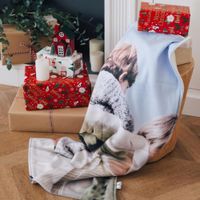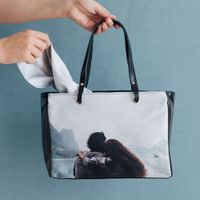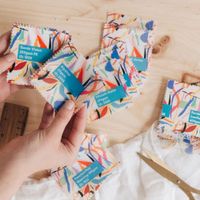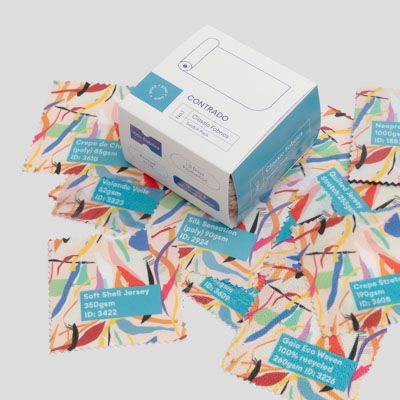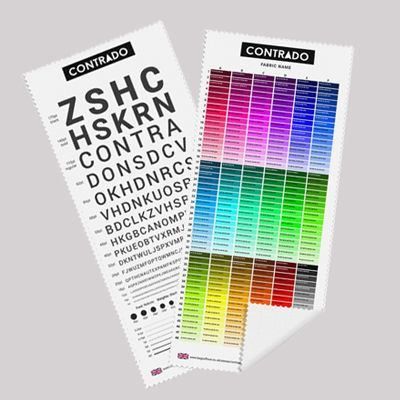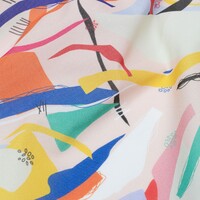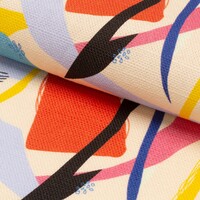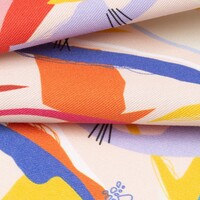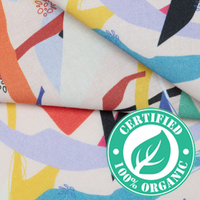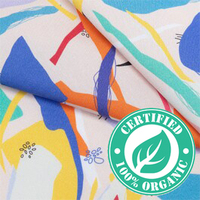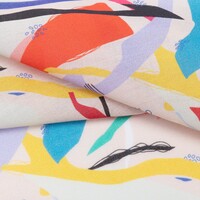![DPI-Print Guideline Icon]()
What's the best resolution to print in?
We print at 200dpi, which is a good combination of quality and file weight. Ideally, your image should be scaled to 100% at 200dpi; this means that no resizing of your file occurs, preventing any interpolation. Our design interface will have a quality marker next to the design that you have uploaded, this will change colour using a traffic light system and display a message. The message will let you know if the resolution is too low or if you have a good quality image.
![scaling-Print Guideline Icon]()
How will my image scale?
When you upload your design our system will automatically scale it to fit your chosen fabric dimensions. In the ‘Product Options’ tab, the displayed dimensions under ‘Print Size’ will show the dimensions of the piece of fabric that you are ordering. For image/design dimensions you need to see the ‘Images & Text Tools’ tab. You can see and edit the dimensions of the image under the quality information next to the thumbnail.
![RGB-CMYK Print Guideline Icon]()
Which colour model should I choose? RGB or CMYK?
We advise providing images in the RGB colour space. Specifically using the sRGB image profile, to achieve best colour results. What does this mean? In your editing software choose RGB as the working space, and assign the image profile as sRGB (full name sRGB IEC61966-2.1)
![Print-Roll Length Fabric Guide Icon]()
Maximum dimensions
For most of our fabrics, there is no limit on the length of the fabric that you can order. We have a preview design window set up to 10m max to visualise the print, but that's not a print limit. If you'd like to order more, increase the quantity (x2 for 20m or x4 for 40m for example) and then you can order as much as you'd like, with a built-in automatic volume discount too. The maximum print width of each fabric can be found on the individual fabric pages or in our design interface.
![Borders-Print Guideline Icon]()
Do I need to incorporate white space within my design if I want a border or some cutting space?
Yes, that might help you! Always incorporate any extra space or boarders into your purchased fabric size. We trim squarely around fabric samples and fabric prints, leaving approximately 5mm white space. Cutting neatly on the line has an additional fee.
![crocking-Print Guideline Icon]()
What is crocking and why might it occur?
Crocking, which is fading along the creases, often after washing or heavy use, occurs when you digitally print on natural fabrics - more so when dark or dense colours are used. It can be minimised by using a cool hand wash instead of machine washing as the tumbling of the machine is the main cause of this. To avoid entirely, we would advise using a poly fabric.
![organics-Print Guideline Icon]()
Why do my colours appear lighter on organic fabrics?
Our organic fabrics do not have any coatings that the non-organic fabrics have. This means the ink absorbs into the fibres, reducing the colour strength slightly (by approx. -40%). For super strong colours we recommend a non-organic natural fabric.
![Transfer-Print Guideline Icon]()
Do you print on fabric a customer supplies?
Unfortunately not; we like to test meticulously so that we know what gets best results on our fabrics, and our facilities cater perfectly to them. We do however print sublimation paper to order, and if you have access to a heat press you can press your own fabrics easily.
![Jpeg-Tiff Print Guideline Icon]()
Should I save my file as a TIFF or JPEG?
For multi-coloured or very detailed files we recommend using a tiff format, but they must be flattened. For simple colours and low detail files, a jpeg is fine.
![Shrinkage-Print Guideline Icon]()
What is the situation with material shrinkage?
Just like many fabric printing processes, there is the potential for shrinkage. Depending on the fabric, please expect and allow between 2-8% shrinkage which you need to plan for in your dimensions. This percentage can vary from print run to print run and between fabrics, so we would advise ordering a little more material than you require for your project.
![Print-Both Sides Print Guideline Icon]()
Can I print on both sides of the fabric?
We do not offer to print on both sides of the fabric. A lot of our fabrics are semi-transparent or have some show through and this wouldn't work with double-sided printing. This is not a service that we offer on any of our fabrics.
![Labels-Print Guideline Icon]()
Can I order labels in another fabric? Would you cut them as you do with the normal fabric labels?
At the moment no, our labels are all printed on the same satin fabric. We may introduce more in the future, but for now, this is the best choice. The labels are all cut the same way. You can order the fabric of your choice and make the labels yourself, but we do not cut different fabric into label format.
![Eco friendly Printing]()
How is your fabric printing eco-friendly?
With environmental consciousness in mind, our fabrics are all printed using completely water-based inks. This means no chemicals or solvents are used. Our heat fixing procedure fixes the colours and prints, avoiding the downsides of steaming, such as excess or contaminated water returning into the waste system. We have one facility in London where we conduct all the printing, production and fulfilment. Rather than roll the fabrics, or send them in a tube, we fold them before they are sent out to you. This saves over 150 tubes a week, as well as a lot of space on the delivery van. (For delicate fabrics we ensure to package appropriately).
![colour palette]()
Why are there slight colour differences between my orders?
We work at improving our colour profiles all the time. Though rare it may happen that from one print run to another, and there could be slight colour differences, this is normal and part of the process when we are constantly improving. It is extremely unlikely that there will be a huge difference (like orange instead of red for example). Please bear in mind such colour variations can be intensified from fabric to fabric due to the varying grains and textures of the fabric; natural fabrics tend to have more muted colours than their poly alternatives. This is due to the construction of the materials as well as the print methods that have to be altered slightly for more delicate, natural textiles.
